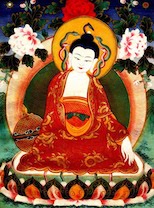Koso Wasan 2
The World-honoured one foretold
That a monk named Bodhisattva Nagarjuna
Would appear in south India and would crush
The wrog views of being and non-being.
The Middle Way

The prediction referred to in this verse can be found in Bodhiruchi's Chinese translation of the Lankavatara Sutra. It describes Nagarjuna as a monk of great virtue. Indeed, from the Dasha-bhumi - the text in which Nagarjuna delineates the Pure Land way as the 'easy path' to nirvana - we can deduce the strong likelihood that he practiced dhuta, a very severe form of monastic rule. If so, it meant that Nagarjuna probably never lay down to sleep, that he always gained his food from a daily alms-round, never ate from anything except his food-bowl and never more than once a day. His robes would always have been discarded rags and he would never have been selective in going about his alms-round, visiting the houses of both friend and foe.
Such a rigorous rule would seem to contradict the principle of the 'Middle Way' which lies at he heart of the dharma and was the first factor in the teaching which Shakyamuni discovered upon leaving behind his period of ascetic practice on his way to enlightenment. However, although the Middle Way is often understood to reflect the idea of steering a course between self-indulgence and asceticism, these two extremes of behaviour are in fact usually seen - from the prespective of the dharma - as being mere symptoms of a deeper malaise. In any case, dhuta is hardly ascetic when compared with the self-torture that Shakyamuni mistakenly undertook in the name of his quest for enlightenment.
In the first instance, self-indulgence is seen as betraying a belief in annihilation at death and asceticism is thought to be a symptom of a belief in eternal individual existence. The former is identified with nihilism and the latter with reifying the self, or materialism; the opposite to the way we would view such things these days, since annihilation at death and self-indulgence is usually associated, now, with materialism.
'Being' and 'non-being' in this verse refers to the fact that the two extreme views which the Buddha Dharma rejects had crept back into Buddhist discourse by Nagarjuna's time, and had become all-pervasive. This was negating the impact and significance of Shakyamuni's teaching. 'Being' (bhava or sad in Sanskrit) and 'non-being' (abhava or asat) could be identified with two of the earlier, Sanskrit-speaking schools. The former erroneous view was upheld by the Sarvastivada (school), representing bhava ('being') and the latter by the Sautrantikas, representing abhava ('non-being'). The first of these sects was focused on the Abhidharma-kosha and the other upon the sutras. In point of fact the main apologists for each of these schools flourished after Nagarjuna's time, so it is fairly obvious that Nagarjuna did not have great impact upon them.
The Sarvastivadans tended to see the constituents of existence (Sk. dharmas) as real, indestructible entities which rose and fell in fractions of time within the consciousness, while the Sautrantikas claimed that the sutras portrayed existence as entirely illusory and that 'cessation' (Sk. nirodha, which in the Sautrantika view was tantamount to nirvana), was an inevitable outcome for all. The first group have been described as realists and the latter as nihilists. Nagarjuna gained recognition by demonstrating in his writings and in his school of the Middle Way (Sk. madhyamika) that emptiness (Sk. shunya ta), which was prominent in the Sautrantika approach, was not 'nothingness' and that the dharmas, so beloved of the Sarvastivadins were not 'durable' but 'empty'.
In this way Nagarjuna set up a metaphysical norm which was completely satisfactory. He neutralised the apparent differences between two competing schools of thought and set up an approach to a conception of the dharma which was free of either extreme.